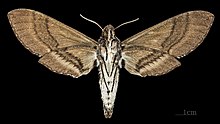
The Sphingidae are a family of moths commonly called sphinx moths, also colloquially known as hawk moths, with many of their caterpillars known as "hornworms"; it includes about 1,450 species. It is best represented in the tropics, but species are found in every region. They are moderate to large in size and are distinguished among moths for their agile and sustained flying ability, similar enough to that of hummingbirds as to be reliably mistaken for them. Their narrow wings and streamlined abdomens are adaptations for rapid flight. The family was named by French zoologist Pierre André Latreille in 1802.
The Three Sisters is a variety of tomato, so named because the plant grows vegetables in three different shapes, each given plant producing only one of the three:
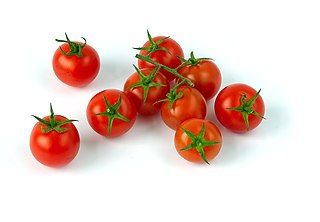
The cherry tomato is a type of small round tomato believed to be an intermediate genetic admixture between wild currant-type tomatoes and domesticated garden tomatoes. Cherry tomatoes range in size from a thumbtip up to the size of a golf ball, and can range from spherical to slightly oblong in shape. Although usually red, other colours such as orange, yellow, green, purple, and black also exist. Those shaped like an oblong share characteristics with plum tomatoes and are known as grape tomatoes. The cherry tomato is regarded as a botanical variety of the cultivated berry, Solanum lycopersicum var. cerasiforme.
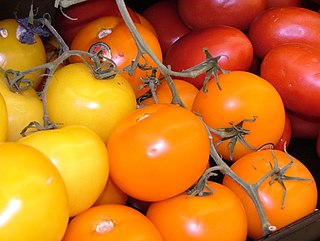
Lycopersicon was a genus in the flowering plant family Solanaceae. It contained about 13 species in the tomato group of nightshades. First removed from the genus Solanum by Philip Miller in 1754, its removal leaves the latter genus paraphyletic, so modern botanists generally accept the names in Solanum. The name Lycopersicon is still used by gardeners, farmers, and seed companies. Collectively, the species in this group apart from the common cultivated plant are called wild tomatoes.
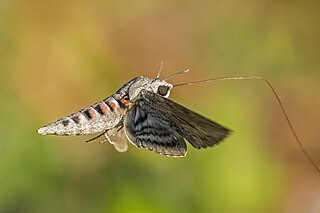
Agrius convolvuli, the convolvulus hawk-moth, is a large hawk-moth. It is common throughout Europe, Asia, Africa, Australia and New Zealand, partly as a migrant. In New Zealand, it is also known as the kumara moth, and in the Māori language as hīhue.
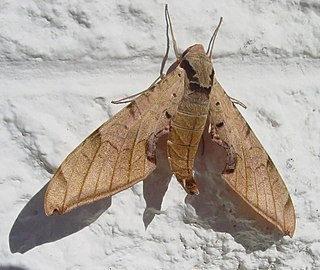
Protambulyx strigilis, the streaked sphinx, is a moth of the family Sphingidae prevalent in the Americas from Florida to Central and South America. The species was first described by Carl Linnaeus in 1771.

Solanum pimpinellifolium, commonly known as the currant tomato or pimp, is a wild species of tomato native to Ecuador and Peru but naturalized elsewhere, such as the Galápagos Islands. Its small fruits are edible, and it is commonly grown in gardens as an heirloom tomato, although it is considered to be wild rather than domesticated as is the commonly cultivated tomato species Solanum lycopersicum. Its genome was sequenced in 2012.

Hemaris tityus, the narrow-bordered bee hawk-moth, is a moth of the family Sphingidae which is native to the Palearctic.

The Sphinginae are a subfamily of the hawkmoths (Sphingidae), moths of the order Lepidoptera. The subfamily was first described by Pierre André Latreille in 1802. Notable taxa include the pink-spotted hawkmoth, being a very common and recognizable species, the death's-head hawkmoths of Silence of the Lambs fame, and Xanthopan morganii with its enormous proboscis.
Benjamin Preston Clark was an American entomologist who specialized in Lepidoptera, especially Sphingidae. He also operated a mercantile business and patented a new form of twine for binding grain.
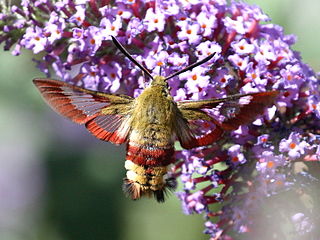
Hemaris fuciformis, known as the broad-bordered bee hawk-moth, is a moth of the family Sphingidae.
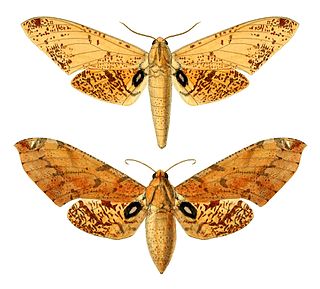
Platysphinx stigmatica is a moth of the family Sphingidae. It is known from forests from Nigeria to the Congo, Angola and western Uganda.

Nephele peneus is a moth of the family Sphingidae. It is known from forests and woodland from Senegal to East Africa, Angola and Delagoa Bay.
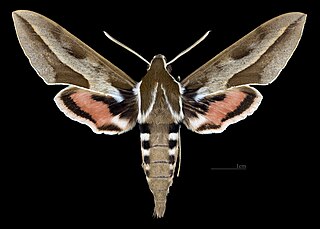
Hyles annei is a moth of the family Sphingidae.
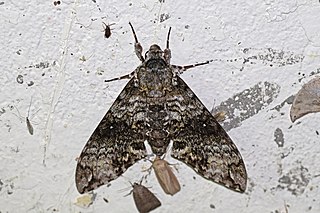
Manduca schausi is a moth of the family Sphingidae. It is found from Mexico, Guatemala, Nicaragua and Costa Rica to Brazil, Argentina and Bolivia.

Matt's Wild Cherry is a cultivar of tomato ostensibly based on the original wild tomato plants, acquired by a friend of Doctor Matt Liebman in Hidalgo, Mexico. Liebman raised this cultivar in Maine, eventually releasing it under his own name. It is species Lycopersicon esculentum var. cerasiforme.
Siberian tomato is a type of the common tomato plant. It is referred to as "Siberian" because it can set fruit at 38 °F (3 °C), although it is not particularly frost hardy, despite its name.

Solanum galapagense is a wild tomato in the family Solanaceae section Lycopersicon and is one of two tomato species endemic to the Galápagos Islands, 500 miles west of Ecuador. It was at these islands where Charles Darwin noted the structural difference between local finches, iguanas, and barnacles, leading him to identify natural selection as a possible source of the origin of species. He also collected plant specimens extensively.
Solanum peruvianum is a species of wild tomato in the family Solanaceae. It is native to the Galápagos Islands, Ecuador, Peru, and northern Chile, and has been introduced to California. Some authorities consider it to be a member of a species complex, with the other members being Solanum corneliomuelleri, Solanum huaylasense, and Solanum arcanum.
Solanum habrochaites, the hairy tomato, is a species of flowering plant in the family Solanaceae, native to Ecuador and Peru. It is considered to be one of the most important sources of genetic variation for crop improvement of the cultivated tomato, Solanum lycopersicum.

